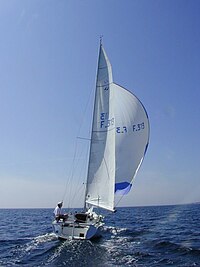 | |
| Name | First Class 8 |
|---|---|
| Boat | |
| Crew | 4–6 |
| Draft | 0.70 m (2.3 ft) / 1.75 m (5.7 ft) |
| Hull | |
| Hull weight | 1,400 kg |
| LOA | 8.5 m (28 ft)[1] |
| LWL | 7.1 m (23 ft) |
| Beam | 2.49 m (8.2 ft) |
| Sails | |
| Mainsail area | 20.30 m2 |
| Jib/genoa area | 18.50 m2 |
| Spinnaker area | 49 m2 |
The First Class 8 (FC8) is a One-Design keelboat designed in 1982 by Group Finot and Jacques Fouroux[1] to be constructed at Beneteau's shipyard.[2]

It is one of Europe's most competitive sailing classes, with more than 1,000 units sold between 1982 and 1994.
Strongest fleets are located in France, Belgium, Spain, Italy, Germany, Norway and Portugal.
It is a long boat compared with its competitors such as the J/24 from America. It has straight lines for a boat of that age and has no reference to IOR hull shapes with huge beam, flared bows, and pinched sterns. The boat's lines lend themselves to a dinghy style planing hull, as opposed to digging a hole in the ocean which was a characteristic of the mid period IOR boats. The FC8 has a lot of wetted surface area which makes it slow in light air.
References
[edit]- ^ a b Jacques Fauroux. "First Class 8 design". Groupe Finot website.
- ^ McArthur, Bruce (2022). "Beneteau". sailboatdata.com. Archived from the original on 30 September 2020. Retrieved 26 March 2022.
Well, that’s interesting to know that Psilotum nudum are known as whisk ferns. Psilotum nudum is the commoner species of the two. While the P. flaccidum is a rare species and is found in the tropical islands. Both the species are usually epiphytic in habit and grow upon tree ferns. These species may also be terrestrial and grow in humus or in the crevices of the rocks.
View the detailed Guide of Psilotum nudum: Detailed Study Of Psilotum Nudum (Whisk Fern), Classification, Anatomy, Reproduction